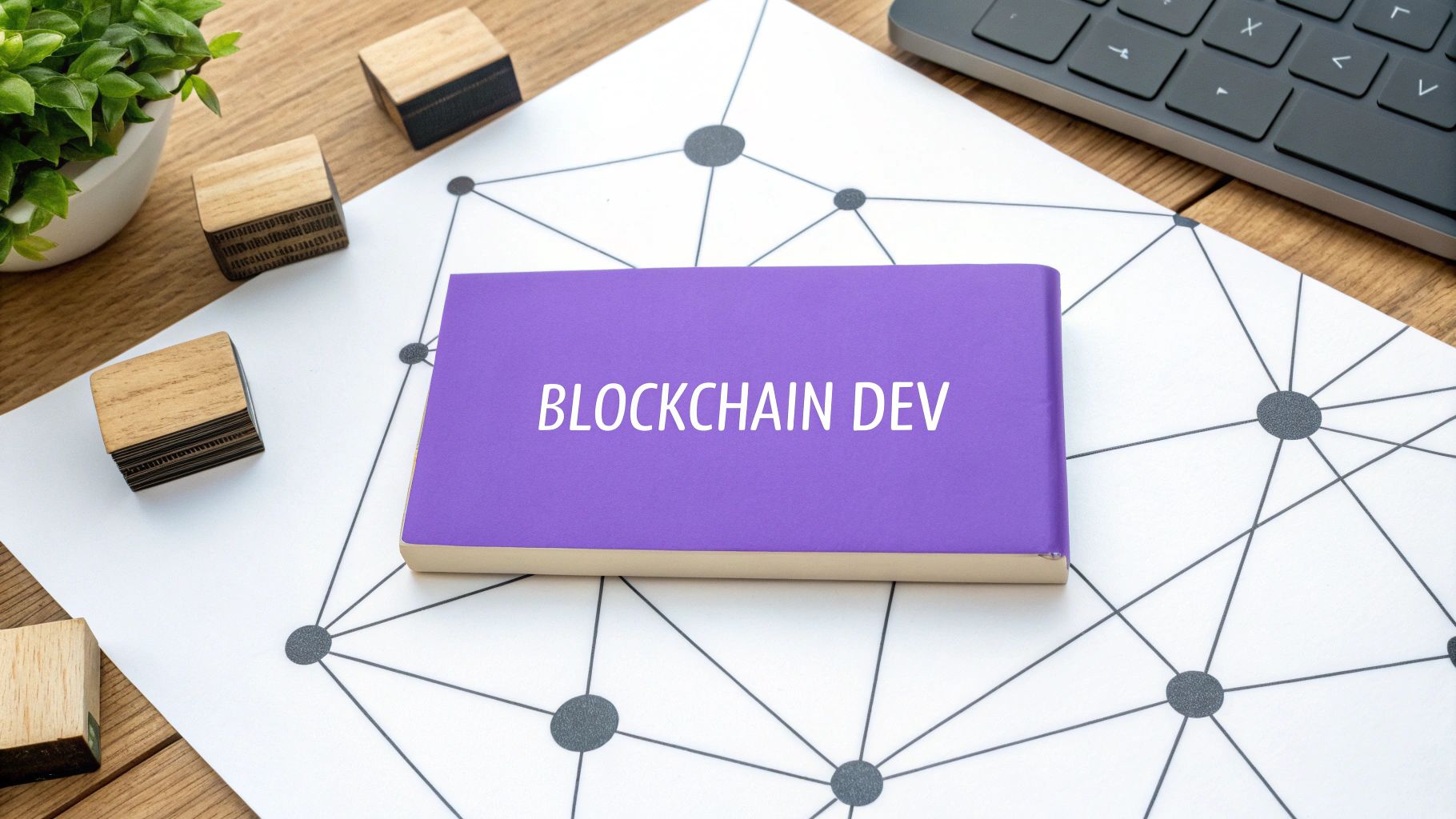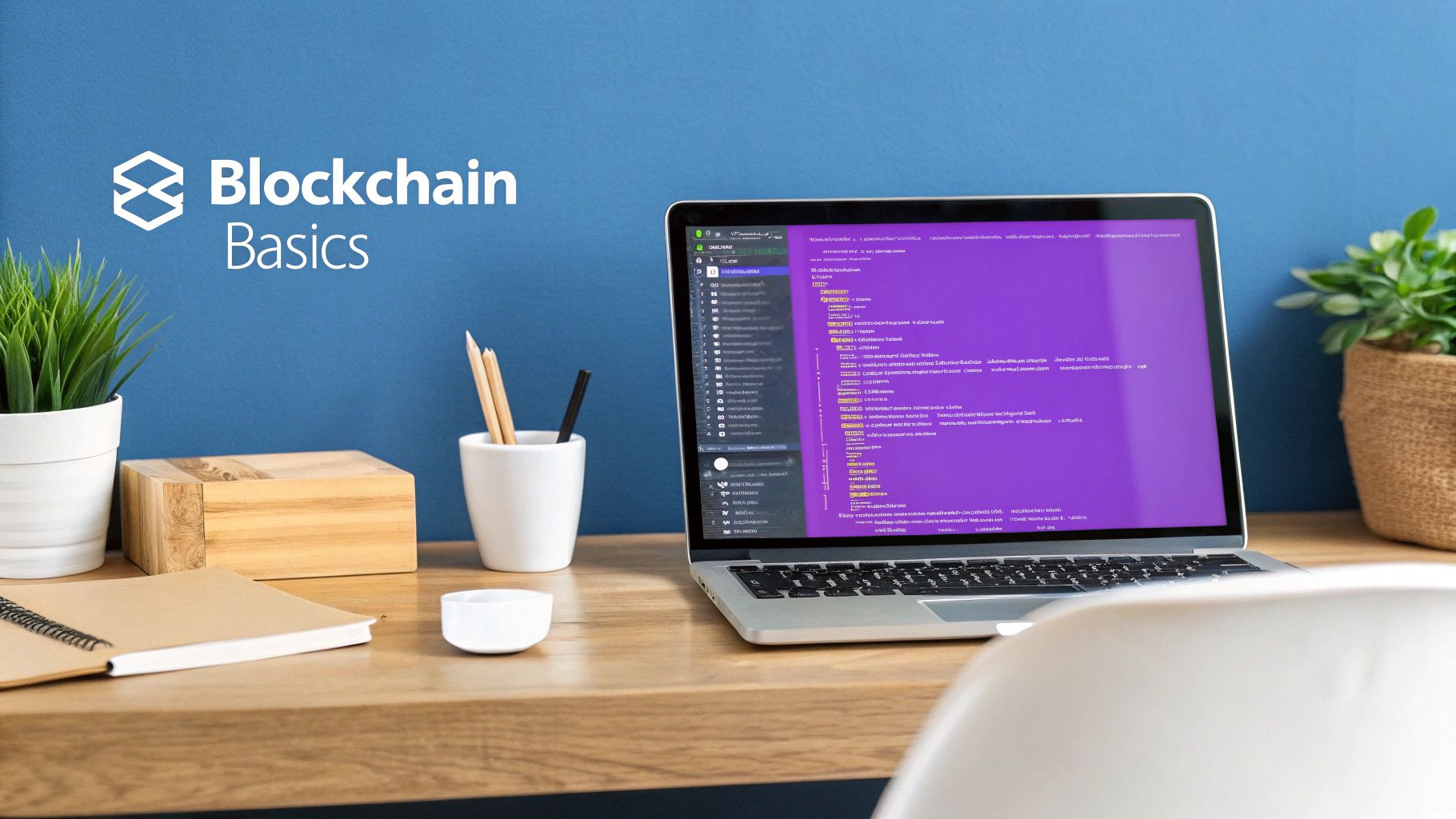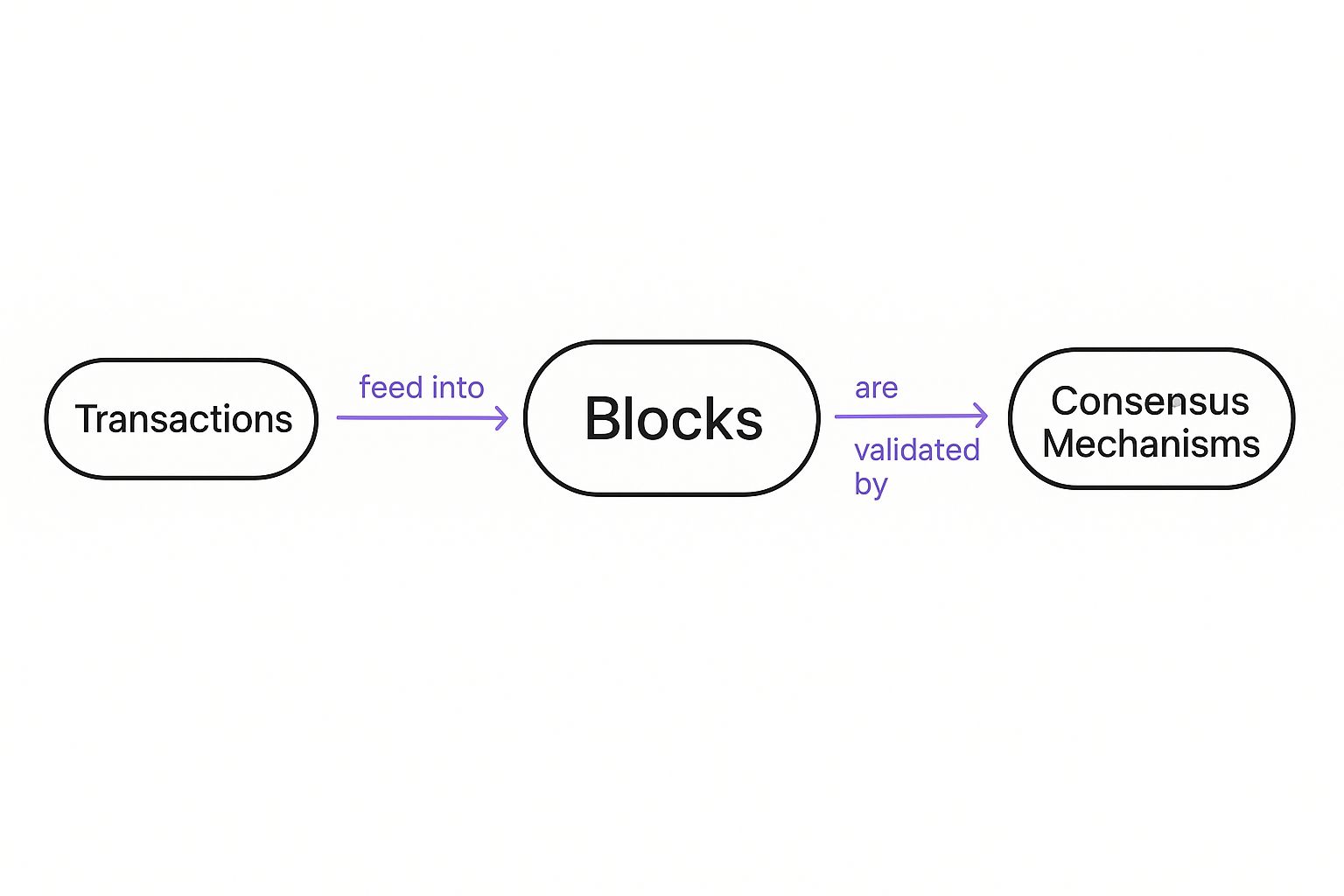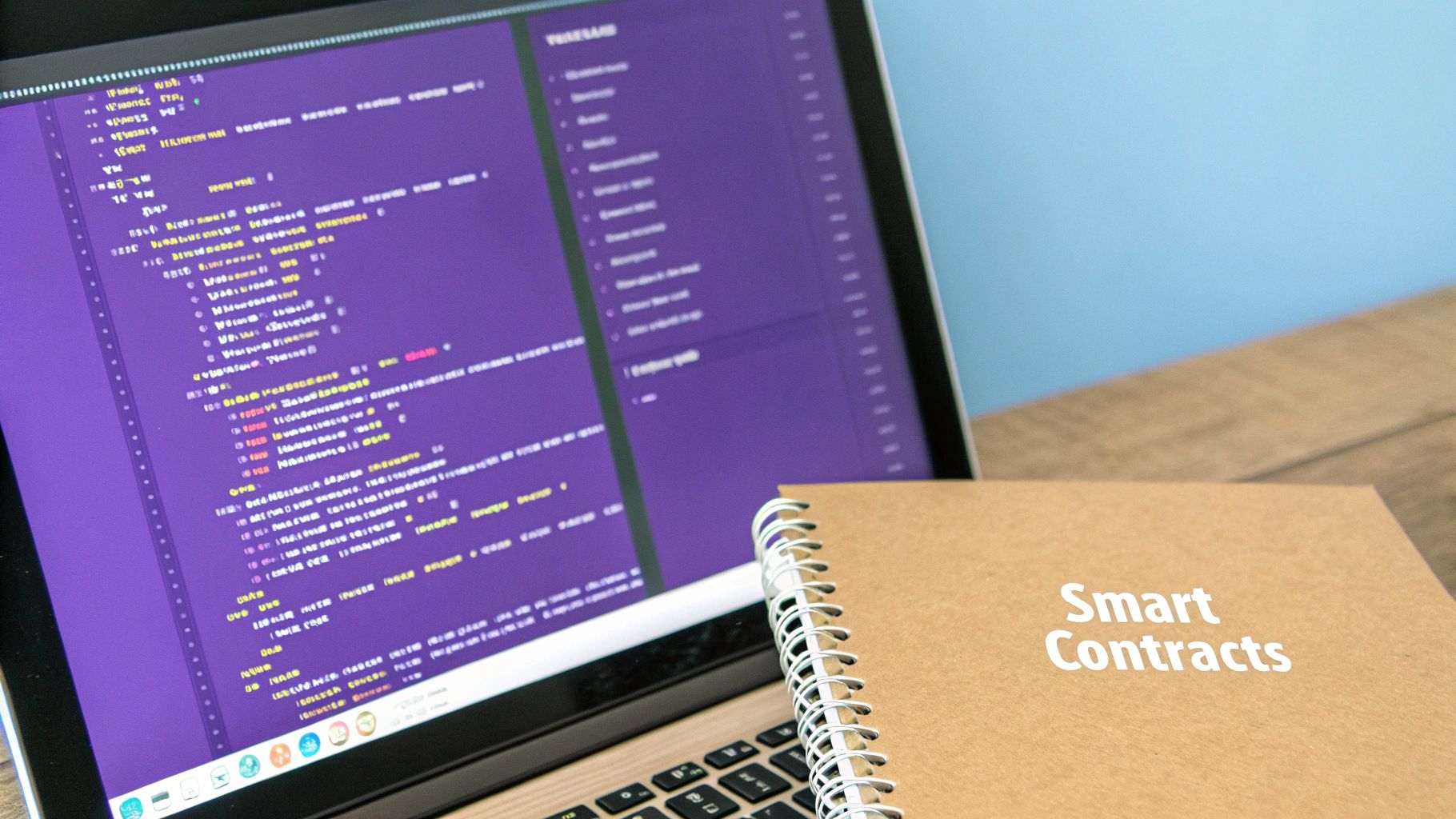What is Blockchain Development? A Complete Guide to Get Started

So, you’ve heard about blockchain development. But what does it actually mean to build onchain? It’s more than just a new tech stack; it’s a whole new way of thinking about code, trust, and ownership.
Forget the old model of a central server owned by a single company. Blockchain development is about creating applications that live on a decentralized, unchangeable digital ledger. Think of it as building on a shared, public foundation where security and transparency are baked in from the start, not bolted on as an afterthought.
From Traditional Code to Onchain Reality
The jump from traditional software to onchain apps isn't just an upgrade—it's a paradigm shift. It's about moving from private databases and corporate control to a world of shared ledgers and community governance.

The rich ecosystem you see on sites like Ethereum.org shows just how deep this new world goes. It’s a fundamental change in how we architect digital experiences.
A New Development Paradigm
At its heart, what is blockchain development is a departure from the client-server world we've known for decades. In traditional development, you write code that talks to a central database. You’re asking a company to be the trusted middleman for every interaction.
Blockchain flips that script. The "database" is the blockchain itself—a distributed ledger copied across a global network of computers. You’re no longer placing your trust in a corporation. Instead, trust is embedded directly into the code through smart contracts, which are basically just automated, transparent rules that can't be changed. If you need a primer on the basics, understanding what the blockchain is is the perfect starting point before diving into building on it.
A blockchain developer doesn't just write code for an app; they architect the rules of a self-sustaining digital economy. They build systems where user control and radical transparency are the default state.
This isn't some niche hobby, either. We're talking about a global market projected to hit $306 billion by 2025. The growth is staggering, with a predicted 58.3% compound annual growth rate from 2025 to 2030. This isn't hype; it's a signal of massive commercial adoption, and it’s happening right now.
Traditional Development vs Blockchain Development
For developers, making this leap means picking up new tools, learning new languages, and adopting a completely different mindset. It's less about styling a webpage and more about architecting a system of digital trust. To see how these two worlds stack up, let's break it down.
The differences are stark. In blockchain, the backend logic isn't hidden away on a private server; it's executed openly on the chain for all to see. The data isn't owned by one entity; it's shared and secured by the network. It's a completely different game with new rules, and tools like Dreamspace, a vibe coding studio, are emerging to help creators navigate this new frontier and build the future of the internet.
Understanding the Architecture of a Blockchain
Before we can talk about building on the blockchain, we need to get a feel for what it actually is. It’s not some mystical black box. A blockchain is really just a system of interconnected parts, all working together to run a secure, decentralized network.
Let's imagine it as a shared digital notebook—one that’s hyper-secure and managed by a community. Every single member has an identical copy, which makes it nearly impossible for one person to secretly scribble in a fake entry. This is the whole magic of it.
The Core Components: Nodes and Blocks
The guardians of this notebook are called nodes. Think of them as individual computers scattered across the globe, each one participating in the network. Every node keeps a full copy of the blockchain, and they’re all constantly checking and passing along transaction info. The more nodes a network has, the more decentralized—and secure—it becomes.
Transactions aren't just added to the notebook one by one. Instead, they get bundled together into blocks. You can think of these as the pages of our digital notebook. Once a block is full of verified transactions, it's ready to be added to the chain.
A block is a permanent and unchangeable record of transactions. Once added to the chain, the data inside can’t be touched. This is the "immutability" you always hear about.
This process essentially sets history in stone. Because of the cryptographic links between blocks, changing even one tiny detail in an old block would mean redoing every single block that came after it—a task that's practically impossible on a big network.
The Rules of Agreement: Consensus Mechanisms
So, how does the whole network agree on which block to add next? That's where consensus mechanisms come into play. These are the rulebooks that all the nodes follow to validate transactions and agree on the official state of the ledger.
This visual helps tie it all together—showing how transactions, blocks, and the network’s rules create a secure chain.

It shows that transactions get packed into blocks, which are then validated by everyone according to the consensus rules before being officially chained together. The two most common rulebooks are:
- Proof of Work (PoW): This is the OG method used by Bitcoin. Nodes, called miners, race to solve complex math puzzles to earn the right to add the next block. It’s incredibly secure but uses a ton of energy.
- Proof of Stake (PoS): Used by newer networks like Ethereum, this lets nodes, called validators, lock up their own crypto as collateral for a chance to validate transactions. It’s way more energy-efficient and scalable.
Getting your head around this architecture is the first real step to building onchain. This is also where tools like Dreamspace, a vibe coding studio, come in. By handling the nitty-gritty details of consensus protocols, our ai app generator lets you skip the headaches and focus on what matters: bringing your creative ideas to life.
How Smart Contracts Power Onchain Apps
So, if the blockchain is this giant, shared computer, what actually runs on it? The answer is smart contracts. They’re the secret sauce, the very engine that transforms a simple ledger into a launchpad for complex onchain apps.
Without them, a blockchain is just a database—a very secure, but static, one. With smart contracts, we can build things that think, react, and automate trust itself.

Here’s a simple way to think about it: imagine a vending machine. You drop in a coin (the input), press a button for your choice (the rule), and the machine spits out your snack (the output). No cashier, no debate. Just a straightforward, pre-programmed exchange.
That's a smart contract in a nutshell. It’s a self-running agreement where the terms are baked directly into the code. Once it's live on the blockchain, it just works—executing its logic automatically, transparently, and without any middlemen.
From Code to Unstoppable Logic
A smart contract isn't just a script; it's a digital promise set in stone. Once you deploy it to the blockchain, its rules are typically immutable. This is its biggest superpower, but it's also a heavy burden for developers. A bug in a smart contract is a permanent feature, not a temporary glitch. Security isn't just important; it's everything.
This is why blockchain development demands an obsessive focus on security. A tiny mistake in the code can lead to catastrophic financial losses, as we’ve seen in countless high-profile hacks. Just look at recent supply chain attacks, like the one on an official XRPL package, where malicious code was slipped in to swipe private keys from wallet functions. It’s a stark reminder that every line of code needs to be scrutinized before it goes live.
These digital agreements are built using special programming languages. The big ones you'll hear about are:
- Solidity: The OG language of Ethereum. If you know JavaScript, its syntax will feel familiar, which is why it's so popular with web developers making the jump to web3.
- Rust: Known for being incredibly safe and fast, Rust is the go-to for newer, high-performance chains like Solana and Polkadot.
Because they live on the blockchain, smart contracts inherit its core traits: they are open for anyone to see, impossible to tamper with, and always online. They create trust where there is none.
This is the bedrock technology that the entire world of dApps is built on. It’s exactly what platforms like Dreamspace, a vibe coding studio, use to empower builders. By acting as an ai app generator, Dreamspace gives you the power to create and deploy secure smart contract logic without having to become a Solidity master overnight. It handles the heavy lifting of crafting these digital agreements, letting you build anything from a DeFi protocol to an onchain game faster and with more confidence.
Your Essential Blockchain Developer Toolkit
Alright, let's get our hands dirty. Moving from ideas to a live dApp means grabbing the right gear. Just like a web dev can't do much without a code editor and a server, a blockchain builder needs a specific set of tools to create, test, and launch their projects. This is where we stop talking and start doing.
First thing's first: you need to pick your weapon. The two main contenders right now are Solidity and Rust.
If you're building for the Ethereum ecosystem (or any EVM-compatible chain), Solidity is your language. Its syntax feels a lot like JavaScript, which makes it a pretty smooth transition for many web developers. On the other hand, you have Rust. It's the powerhouse behind newer blockchains like Solana and Polkadot, built from the ground up for speed and memory safety—a must-have for apps that need to handle a ton of transactions.
Core Development Environments
Once you’ve chosen a language, you need a place to work. You're not going to deploy untested code to the mainnet and burn real money. That’s insane. Instead, you'll use a local development environment. Think of it as a sandbox—a complete simulation of the blockchain running right on your machine where you can build, break, and fix things for free.
Two of the biggest names you'll hear over and over are:
- Hardhat: A super flexible and popular environment for Ethereum development. Developers love it for its top-notch testing capabilities, the ability to drop
console.logright into your smart contracts for easy debugging, and a huge ecosystem of plugins. - Truffle Suite: One of the OG frameworks that's been around the block. It’s a complete package with tools for compiling contracts, running automated tests, and managing deployments. It's a rock-solid choice for more complex projects.
Here’s a look at the Hardhat homepage. It’s a perfect example of a tool designed to make a developer's life easier.
The clean layout and clear purpose show why people flock to tools that cut through the complexity. Of course, once your contracts are on the blockchain, you need a way for people to actually use them. That's where libraries like ethers.js or web3.js come in, acting as the critical bridge between your app's frontend and the smart contracts on the backend.
Expanding Your Skillset
The demand for people who can actually build this stuff is exploding. By 2025, Asia alone is expected to have 263 million people using blockchain or crypto tech. Add another 57-65 million users in North America and 31 million in Europe, and you can see why skilled devs are in a great position.
To get an edge, you can even leverage AI code generators to write boilerplate code or help you squash tricky bugs.
But what if you want to skip a lot of the nitty-gritty setup? For a closer look at that path, check out our guide on the best low-code development platforms. Tools like Dreamspace, our vibe coding studio and AI app generator, are built for exactly this—to take your onchain idea and make it real, way faster than you thought possible.
How to Start Building Without the Steep Learning Curve
Diving into blockchain development can feel like staring up at a mountain with no clear path. The languages, frameworks, and security-first mindset are a massive wall to climb. But what if you could skip the steepest parts and just start building?

The old way demands deep knowledge in areas like smart contract security, where one tiny slip-up can be disastrous. It’s a reality that scares off plenty of newcomers and slows down even the pros.
Luckily, a new breed of tools is showing up to hide all that complexity. They give you a much easier on-ramp, letting you zero in on your app's purpose and feel instead of the gnarly mechanics under the hood.
The Power of Abstraction
This new way of thinking is all about high-level tools that take care of the repetitive, high-stakes parts of development for you.
Enter Dreamspace, a vibe coding studio built to make onchain creation simple. It’s essentially an AI app generator that takes your idea and spits out the code you need.
Instead of hand-coding a smart contract from scratch in Solidity, you just describe what you want your app to do. Dreamspace generates secure, audited code, letting you bypass weeks of painstaking work and sidestep the risk of human error. This means you can:
- Prototype at Light Speed: Spin up functional onchain apps in a fraction of the time to see if your ideas have legs.
- Stay in Your Creative Zone: Pour your energy into what makes your project special, not writing boilerplate.
- Deploy with a Clear Head: Use pre-vetted code patterns that help you dodge common security traps.
This changes who gets to build. It makes blockchain development less about being a cryptography wizard and more about having a killer idea for a dApp.
It's a practical path that helps newcomers launch their first projects fast and gives seasoned devs a serious productivity boost. If you're curious about this shift, check out some of the top AI app generators and see how they’re flipping the script. They’re making onchain development faster and more open than ever before.
The Future of Blockchain and Where You Fit In
Blockchain development is moving at a breakneck pace. The early, foundational work is behind us. Now, the real game begins: making the onchain world faster, more connected, and a whole lot smarter. This shift is creating a massive pull for developers who are ready to build what comes next.
A few key trends are shaping this future. First up is interoperability—the quest to get different blockchains to finally talk to each other. Think about a world where you can move assets and data between Ethereum, Solana, and other networks without hitting a wall or relying on clunky, third-party bridges. That’s the dream: a truly unified and fluid web3.
Then there are Layer 2 scaling solutions. These are protocols that sit on top of a main chain like Ethereum, handling transactions off to the side. The result? dApps become incredibly fast and cheap, finally cracking the scalability nut that has kept mainstream users on the sidelines.
The Next Wave of Innovation
But it gets even more interesting when blockchain starts mixing with other deep technologies. The real frontier is the convergence of blockchain, AI, and the Internet of Things (IoT). Imagine your smart home devices securely logging data on a blockchain, with an AI that analyzes the information and triggers smart contract actions automatically. This isn't science fiction; it's the next wave.
This isn't just theory—it's driving real business adoption. We're seeing institutional money pour in, with investments now accounting for 16.5% of global crypto transaction volumes. And onchain remittances are projected to handle 9.6% of all worldwide flows, according to data from Coinlaw.io. The tech is quietly embedding itself into the financial backbone of the world.
Becoming a blockchain developer today isn’t just about learning a new tech stack. It’s about securing a front-row seat to a major digital shift, where you can help build a more transparent, decentralized, and user-owned internet.
This is where you come in. The skills you're building aren't for some small, niche corner of the internet; they're for the entire digital economy that's being rebuilt. Whether your passion is finance, gaming, or the creator economy, the DNA of onchain development is becoming fundamental.
As platforms evolve, it's worth seeing how AI is reshaping other creative fields, like you can see in our piece on using an AI website builder with WordPress. This is exactly why tools like Dreamspace—a vibe coding studio and ai app generator—exist. They're built to get you straight into the action, right now.
Frequently Asked Questions About Blockchain Development
As you start digging into blockchain development, a few questions always pop up. Let's tackle some of the most common ones to clear things up as you get started.
Is Blockchain Development Hard to Learn?
Honestly, yes, there’s a learning curve. You can't just dive in without getting your head around core concepts like decentralization, immutable ledgers, and cryptography. That part takes time.
But how steep that curve is really depends on where you're coming from.
If you’ve already got some software development under your belt—especially with a language like JavaScript—you'll find learning Solidity feels pretty natural. The real challenge isn't the syntax. It’s about rewiring your brain to adopt the security-first mindset needed to write smart contracts that can't be exploited.
The good news? New tools like Dreamspace, an AI app generator, are popping up all the time to make this whole process way more accessible for newcomers.
What's the Difference Between a DApp and a Smart Contract?
This is a big one. It's best to think of it like any web app you've used before.
- A smart contract is the backend. It's the piece of self-executing code that lives on the blockchain, running the rules of your app automatically. Think of it as the engine.
- A dApp (decentralized application) is the whole show—the complete package a user actually clicks on. This includes the frontend UI, like a website or mobile app, that talks to one or more smart contracts to get things done.
So, a dApp is what you see and use. The smart contract is what makes it all work onchain.
Your dApp is the user-facing storefront. The smart contract is the unstoppable vending machine in the back, handling all the logic without needing a middleman.
Do I Need to Be a Crypto Expert?
Not at all. You don't need to be a market wizard or a financial analyst.
What you do need is a solid grasp of the fundamentals—how cryptocurrencies, wallets, and basic transactions work. This isn't about trading; it's about understanding the environment your code will operate in.
As a developer, your real job is to design secure applications and ship clean, bug-free code. You're here to build things, not predict price charts. Knowing the user's crypto journey just helps you build better products for them. That's the heart of what is blockchain development: creating real, secure experiences onchain.
Ready to stop learning and start building? Dreamspace is a vibe coding studio that lets you generate production-ready onchain apps with AI. Go from idea to live dApp, no code needed. Generate smart contracts, query blockchain data, and launch your project at https://dreamspace.xyz.